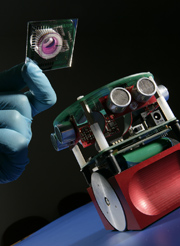이 기술이 더 발전하면 로보캅, 인조인간 되는 거 아닌가?

영국의 레딩대학 연구팀은 쥐의 배아에서 뇌조직을 추출해 뉴런(신경 단위) 별로 분리하고, 약 30만개의 뉴런을 영양분·항생제와 함께 작은 용기에
담아 전극을 꽂았다. 이 전극은 근거리무선통신망에 연결되고 뉴런들은 통신망을 통해 바퀴 달린 로봇과 교신한다. 로봇의
진행 방향에 장애물이 있으면 뉴런들에 일정한 전기자극이 가고, 뉴런들도 전기자극을 보내 로봇을 조종하는
방식이다.
연구팀은 쥐의 뉴런이 충분한 학습을 통해 주변 환경에 대한 ‘기억’을 구성하기 시작하면 화학·전기적 자극으로 기억력을 손상시켜 나타나는 현상을 관찰할 예정이다. 이를 통해 알츠하이머·파킨슨 병처럼 뇌 기능이 떨어지는 병에 대한 실마리를 찾을 것으로 연구팀은 기대하고 있다.
생명 조직과 기계를 연결하는 ‘하이브리드 로봇’ 연구는 미국 조지아기술연구소의 스티브 포터 박사에 의해 2003년 처음 시도됐다.
Press releases (http://www.rdg.ac.uk/)
Robot with a Biological Brain: new research provides insights into how the brain works
Release Date : 14 August 2008
The robot's biological brain is made up of cultured neurons which are placed onto a multi electrode array (MEA). The MEA is a dish with approximately 60 electrodes which pick up the electrical signals generated by the cells. This is then used to drive the movement of the robot. Every time the robot nears an object, signals are directed to stimulate the brain by means of the electrodes. In response, the brain's output is used to drive the wheels of the robot, left and right, so that it moves around in an attempt to avoid hitting objects. The robot has no additional control from a human or a computer, its sole means of control is from its own brain.
The researchers are now working towards getting the robot to learn by applying different signals as it moves into predefined positions. It is hoped that as the learning progresses, it will be possible to witness how memories manifest themselves in the brain when the robot revisits familiar territory.
Professor Kevin Warwick from the School of Systems Engineering, said: "This new research is tremendously exciting as firstly the biological brain controls its own moving robot body, and secondly it will enable us to investigate how the brain learns and memorises its experiences. This research will move our understanding forward of how brains work, and could have a profound effect on many areas of science and medicine."
Dr Ben Whalley from the School of Pharmacy, said: "One of the fundamental questions that scientists are facing today is how we link the activity of individual neurons with the complex behaviours that we see in whole organisms. This project gives us a really unique opportunity to look at something which may exhibit complex behaviours, but still remain closely tied to the activity of individual neurons. Hopefully we can use that to go some of the way to answer some of these very fundamental questions. "
'etc > 창고' 카테고리의 다른 글
| 레슬링, 탁구, 야구 네덜란드전등 20일 한국선수 주요경기 시간, 일정 - 베이징 올림픽 2008.08.20 (0) | 2008.08.20 |
|---|---|
| 탁구, 체조등 한국선수 19일 경기 일정, 시간 - 베이징 올림픽 2008.08.19 (0) | 2008.08.19 |
| 야구 대만전등 18일 경기 시간, 일정 - 베이징 올림픽 2008.08.18 (0) | 2008.08.18 |
| 배드민턴 혼합복식 결승, 야구 한국-중국전등 17일 주요경기 일정, 시간 - 베이징 올림픽 2008.08.17 (0) | 2008.08.17 |
| 여자 역도 장미란, 야구 한일전등 16일 주요경기 일정, 시간 - 베이징 올림픽 2008.08.16 (0) | 2008.08.16 |
| 박태환 1500m 수영 예선, 양궁 남자 개인전등 15일 주요경기 시간, 일정 - 베이징 올림픽 - 2008.08.15 (0) | 2008.08.15 |
| 광복절 특선 영화, 특집 편성물 - 아이스 에이지(Ice Age, 2002) - 2008.08.15 (0) | 2008.08.15 |
| 여자 양궁, 남자 체조등 베이징올림픽 14일 주요경기 시간, 일정표 - 2008.08.14 (0) | 2008.08.14 |
| 양궁 남자 개인전등...베이징 올림픽 13일 주요경기 일정, 시간 - 2008.08.13 (0) | 2008.08.13 |
| 박태환 결승 (수형 자유형 200m 은메달)...베이징올림픽 12일 주요경기일정(방송시간) - 2008.08.12 (0) | 2008.08.12 |



